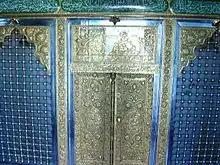Umm Kulthum bint Ali
Zaynab al-Sughra (Arabic: زَيْنَب ٱلصُّغْرَىٰ, lit. 'Zaynab the Younger'), also known by her kunya Umm Kulthum bint Ali (Arabic: أُمّ كُلْثُوم بِنْت عَلِيّ), was the granddaughter of the Islamic prophet Muhammad and the daughter of Ali. Whether or not she married Umar is a controversial topic between Sunnis and Shia.[1] She is given the epithet 'the Younger' to distinguish her from her older sister, Zaynab the Elder (Zaynab al-Kubra).[2]
| Part of a series on |
| Islam |
|---|
 |
|
Umm Kulthum bint Ali | |
|---|---|
أُمّ كُلْثُوم بِنْت عَلِيّ | |
 | |
| Born | 4 February 627 (18 Rabi' al-awwal AH 6) |
| Died | Damascus, Umayyad Empire |
| Resting place | Sayyidah Zaynab Mosque, Damascus, or Baab Sagheer, Damascus, Syria |
| Known for | Being a granddaughter of the Islamic prophet Muhammad |
| Spouse(s) | Umar, Awn, Muhammad, Abdullah |
| Children | Zayd, Ruqayyah bint Umar |
| Parents |
|
| Relatives | |
| Family | House of Muhammad |
Family
She was born around 6 AH[3] as the fourth child of Ali and of Muhammad's daughter, Fatimah. Her siblings were Hasan, Husayn and Zaynab al-Kubra.[4]:18 Muhammad gave her the kunya 'Umm Kulthum' because she closely resembled his daughter, Umm Kulthum bint Muhammad, Zaynab's maternal aunt.[5]
First marriage
Sunni belief
Ali wanted his daughters to marry his brother Ja'far's sons, but Umm Kulthum's hand in marriage was requested by the Caliph, who promised, "No man on the face of the earth will treat her better than I will."[4]:299
Ali protested that she had not yet reached puberty,[4]:299,300 but Umar commanded that she be presented to him. Ali gave his daughter a striped garment and instructed her: "Take this to the Commander of the Faithful and tell him: 'My father says, "If you like this garment, keep it; if you don't like it, return it."'" When Umm Kulthum brought this message to Umar, she reported, "He did not undo the garment nor look at anything except at me." He told her that he was pleased, and so Ali consented to the marriage.[4]:299–300 Umar gave his bride a dower of 40,000 dirhams,[6] and the marriage was consummated in November or December 638 (Dhu'l-Qaada 17 AH).[7]
They had two children, Zayd and Ruqayya.[4]:299,300[8] Ruqayya later married Ibrahim, a son of Sa'd ibn Abi Waqqas, by whom she had a daughter.[9]
One story from their married life tells how Umm Kulthum sent a gift of perfume to the Empress of Byzantium. The Empress sent back a "superb" necklace for Umm Kulthum. Umar believed that his wife should not have conducted a private correspondence at the expense of the state postal service, so he reimbursed her for the cost of the perfume and placed the Empress’s necklace in the state treasury.[10] Nevertheless, it was said that Umar treated Umm Kulthum "with extreme honour and respect" because she was Muhammad's granddaughter.[11]
Twelver Shia belief
However, Shiites are of the view this marriage with Umar did not happen at all. She married to Awn ibn Jafer(Ja'far) ibn Abi Talib and then (after his death) to his younger brother Muhammad.[12]
Subsequent marriages
After Umar's death in 644, Umm Kulthum married her young cousin, Ja'far's son Awn,[25] for a dower of 4,000 dirhams. Her brother Hasan remarked that he had never seen such passionate love as Umm Kulthum's for Awn. However, Awn died after only a short time.[26]
After Awn's death, Ali married Umm Kulthum to Awn's brother Muhammad,[4]:299[13] again for 4,000 dirhams. But Muhammad also died.[26]
After the death of her husband Muhammad, Umm Kulthum became one of the wives of Awn and Muhammad's eldest brother, Abdullah,[29] who had divorced her sister Zaynab al-Kubra.[30]. With respect to divorce the book of Muhammad Al-Munajjid discloses that Zaynab died while married to him (Abdullah bin Jafar).[31] Umm Kulthum remarked: "I was not shy with [my mother-in-law] Asma bint Umays. Two of her sons died while married to me, but I did not fear this for the third."[4]:299
Umm Kulthum had no children by any of her three latter marriages.[4]:299
Battle of Karbala
She is reported to have been present at the Battle of Karbala, during which her earings were taken from her by an attacking soldier.[32][33] Afterwards, Umm Kulthum is said to have given a eulogy condemning the people of Kufa for abandoning her brother Husayn, who was killed in the battle.[34]
Death

Umm Kulthum and her son Zayd died at the same time, in Abdullah's lifetime. Eighty people attended their funeral,[4]:299 where Sa'id ibn al-'As conducted the prayers, and the congregation included Abdullah ibn Umar and Abu Hurairah.[35]
Umm Kulthum is buried in Baab Sagheer cemetery in Damascus, Syria . The Mausoleum of Umm Kulthum is located in Arrawiya village in Damascus.
Fatimids believe that she is also known as "Zaynab the Younger" and that she is buried at Sayyidah Zaynab Mosque, Damascus; whereas Zaynab the Elder lived at the end of her life in Cairo[36] and was buried there at Al-Sayeda Zainab Mosque.[37]
References
- Shams ad-Din al-Dhahabi. Siyar A`lam al-Nubala'. (2001). Volume 3: Kibar al-Tabi'in, p. 501. Beirut: Resalah Publishing House.
- Al-Shaykh al-Mufid. Kitab al-Irshad. Volume 1, p. 354.
- Shams ad-Din al-Dhahabi. Siyar A`lam al-Nubala'. (2001). Volume 3: Kibar al-Tabi'in, p. 500. Beirut: Resalah Publishing House.
- Muhammad ibn Saad. Kitab al-Tabaqat al-Kabir Volume 8. Translated by Bewley, A. (1995). The Women of Madina. London: Ta-Ha Publishers.
- Abbas al-Qumi. Al-Kuna wal al-Alqab. (1989). Volume 1 (5th edition), p. 228.
- Muhammad ibn Jarir al-Tabari. Tarikh al-Rusul wa'l-Muluk. Translated by Smith, G. R. (1994). Volume 14: The Conquest of Iran, p. 101. Albany: State University of New York Press.
- Muhammad ibn Jarir al-Tabari. Tarikh al-Rusul wa'l-Muluk. Translated by Juynboll, G. H. A. (1989). Volume 13: The Conquest of Iraq, Southwestern Persia, and Egypt, pp. 109-110. Albany: State University of New York Press.
- Muhammad ibn Saad. Kitab al-Tabaqat al-Kabir vol. 3. Translated by Bewley, A. (2013). The Companions of Badr, p. 204. London: Ta-Ha Publishers.
- ibn Sa'd, Muhammad; Bewley, Aisha (2000). The Men of Madina. Two. Ta-Ha. p. 112. ISBN 978-1-897940-90-7.
- Muhammad ibn Jarir al-Tabari. Tarikh al-Rusul wa'l-Muluk. Translated by Humphreys, R. S. (1990). Volume 15: The Crisis of the Early Caliphate, p. 28. Albany: State University of New York Press
- Muhammad ibn Ismail ibn Kathir. Al-Sira al-Nabawiyya. Translated by Le Gassick, T. (2000). The Life of the Prophet Muhammad Volume 4, p. 438. Reading, UK: Garnet Publishing.
- Umar's Marriage to Umm Kulthum in Shiite Narrations. LPGA (n.d) Retrieved from https://www.al-islam.org/critical-assessment-umm-kulthums-marriage-umar-sayyid-ali-al-husayni-al-milani/section-4-umars.
- Muhammad ibn Ismail ibn Kathir. Al-Sira al-Nabawiyya. Translated by Le Gassick, T. (2000). The Life of the Prophet Muhammad Volume 4, pp. 418, 438. Reading, U.K.: Garnet Publishing.
- Shustari, Qazi Nurullah. Majalis ul-Mo'mineen. pp. 85–89.
- al-Murtaza, Sharif. Al-Shaafi. p. 116.
- Al-Hadid, Hibatullah. Sharh Nahj ul-Balagha. 3. p. 124.
- Majlisi, Muhammad Baqir. Bihar al-Anwar. p. 621.
- Ardabili, Muqaddas. Hadiqat al-Shi'a. p. 277.
- Shustari, Qazi Nurullah. Masa'ib un-Nawasib. p. 170.
- Al-Amili, Zayn al-Din al-Juna'i. "Lawahiq-al-'Aqd". Masalik al-Ifham fi Sharh Shara-il-Islam. 1.
- Qumi, Abbas. Muntahi al-Aamal. 1. p. 186.
- Shahidi, Sayyed Ja'far. Life of Fatemeh Zahra(SA). pp. 263–265.
- Baqir, Muhammad. Mir'at ul-Uqool. 21. p. 199.
- Al-Tusi, Nasir Al-Din. Al-Mabsoot. 4. p. 272.
- [4]:299[13][14][15][16][17][18][19][20][21][22][23][24]
- Guillaume, A. (1960). New Light on the Life of Muhammad, p. 51. Manchester: Manchester University Press.
- Al-Tusi, Nasir Al-Din. Al-Mabsoot. pp. Volume 4, pg 272.
- Baqir, Muhammad. Mir'at ul-Uqool. pp. Volume 21, pg 199.
- [4]:299[13][27][28]
- Lammens, H. (1912). Fatima et les filles de Mahomet, pp. 125-126. Rome: Scripta Pontificii Instituti Biblici.
- Al-Munajjid, Muhammad Saalih. HOW HE TREATED THEM (2014 (First) ed.). Riyadh, Saudi Arabia: Zad Publishing. p. 128. ISBN 978-603-01-6237-6.
- al-Qurashi, Baqir Shareef. The Life of Imam Husain (as). p. 1502.
- Muzaffari. Tarikh. p. 208.
- al-Majlisi, Allamah Muhammad Baqir (1694–1698). Bihar al-Anwar, Volume 45.
- Nasa'i 3:21:1980.
- "Balaghatun Nisa", by Abul Fazl Ahmad bin Abi Tahir
- The Shi'i World: Pathways in Tradition and Modernity; edited by Farhad Daftary, Amyn Sajoo, Shainool Jiwa; page 216